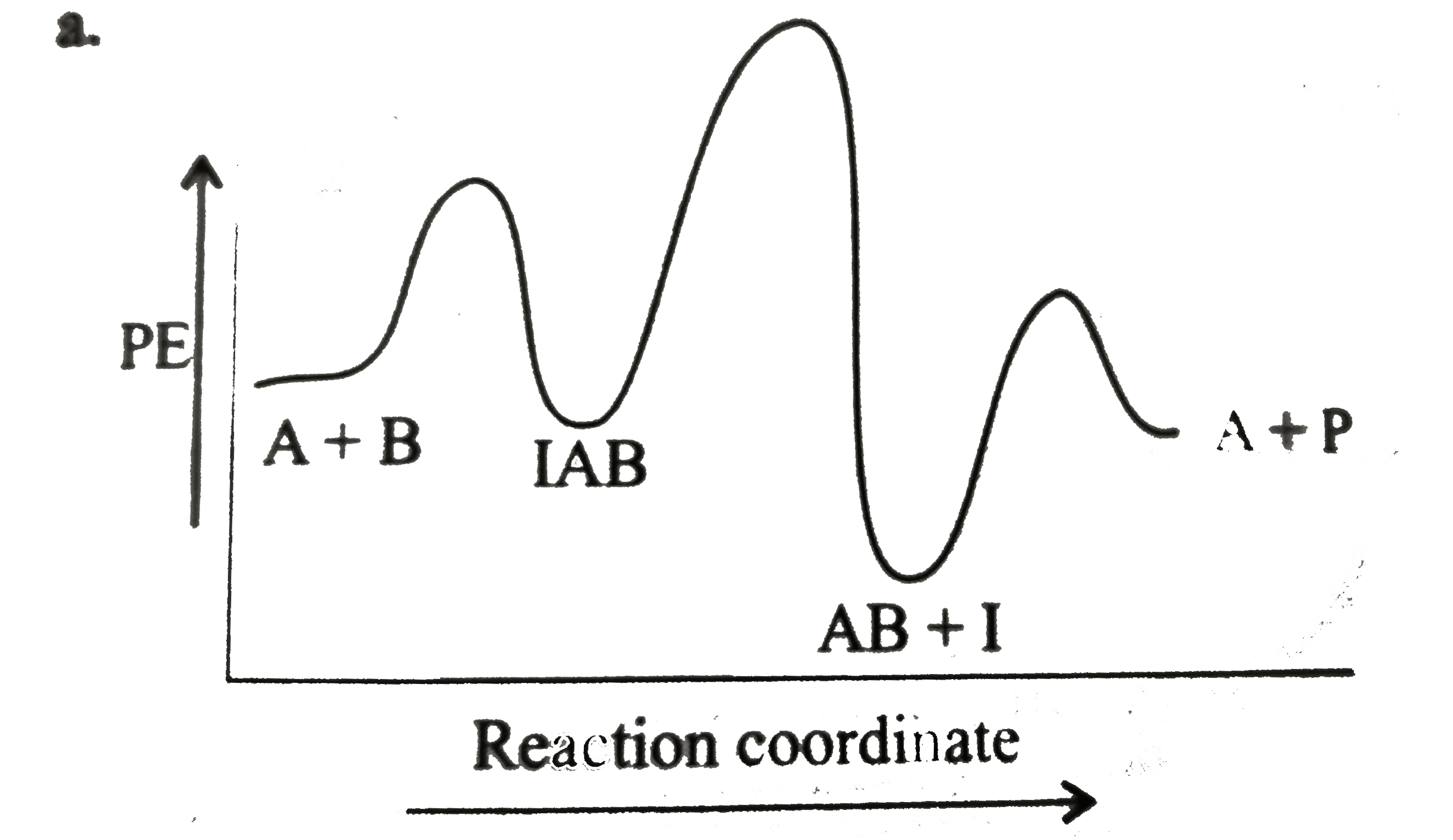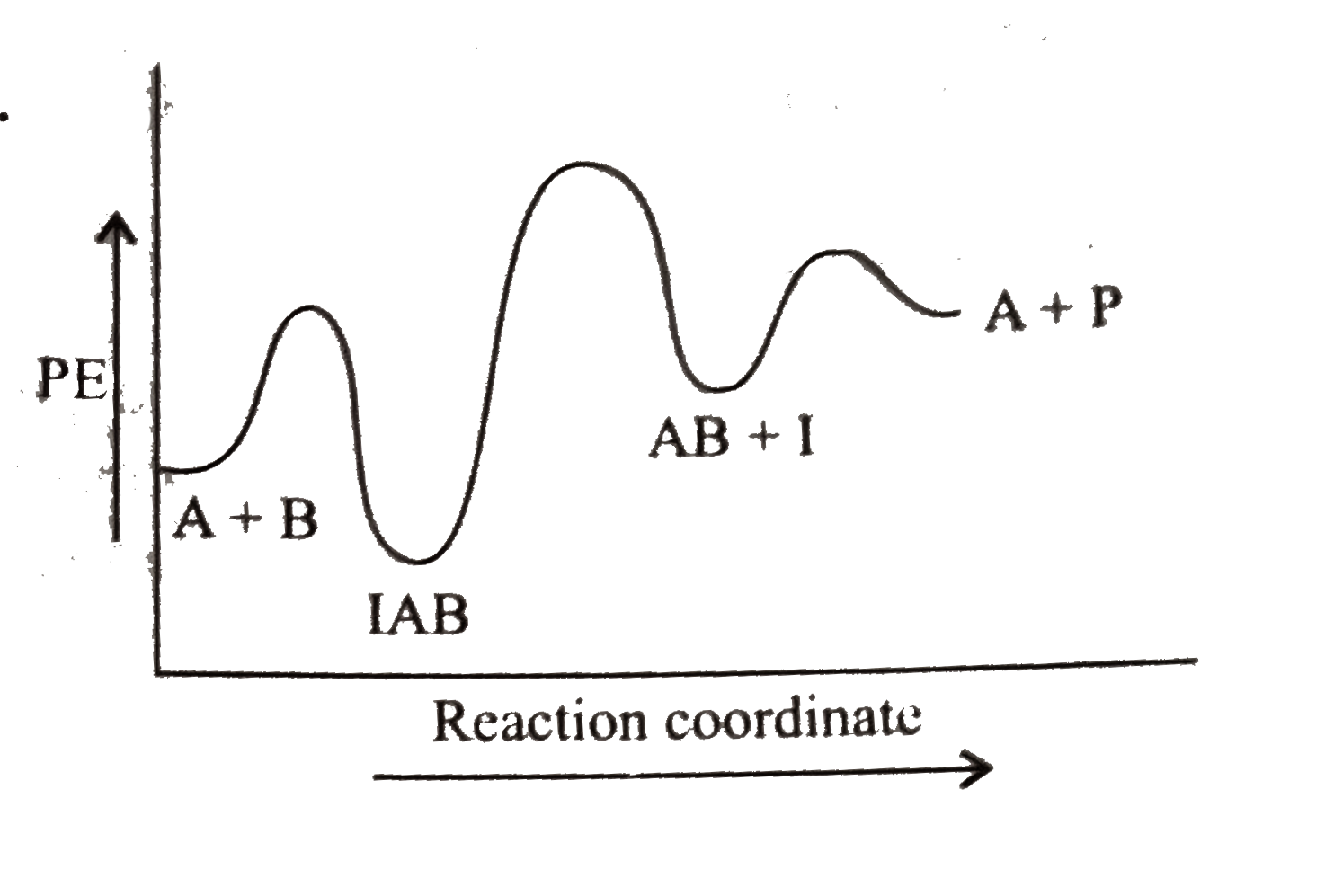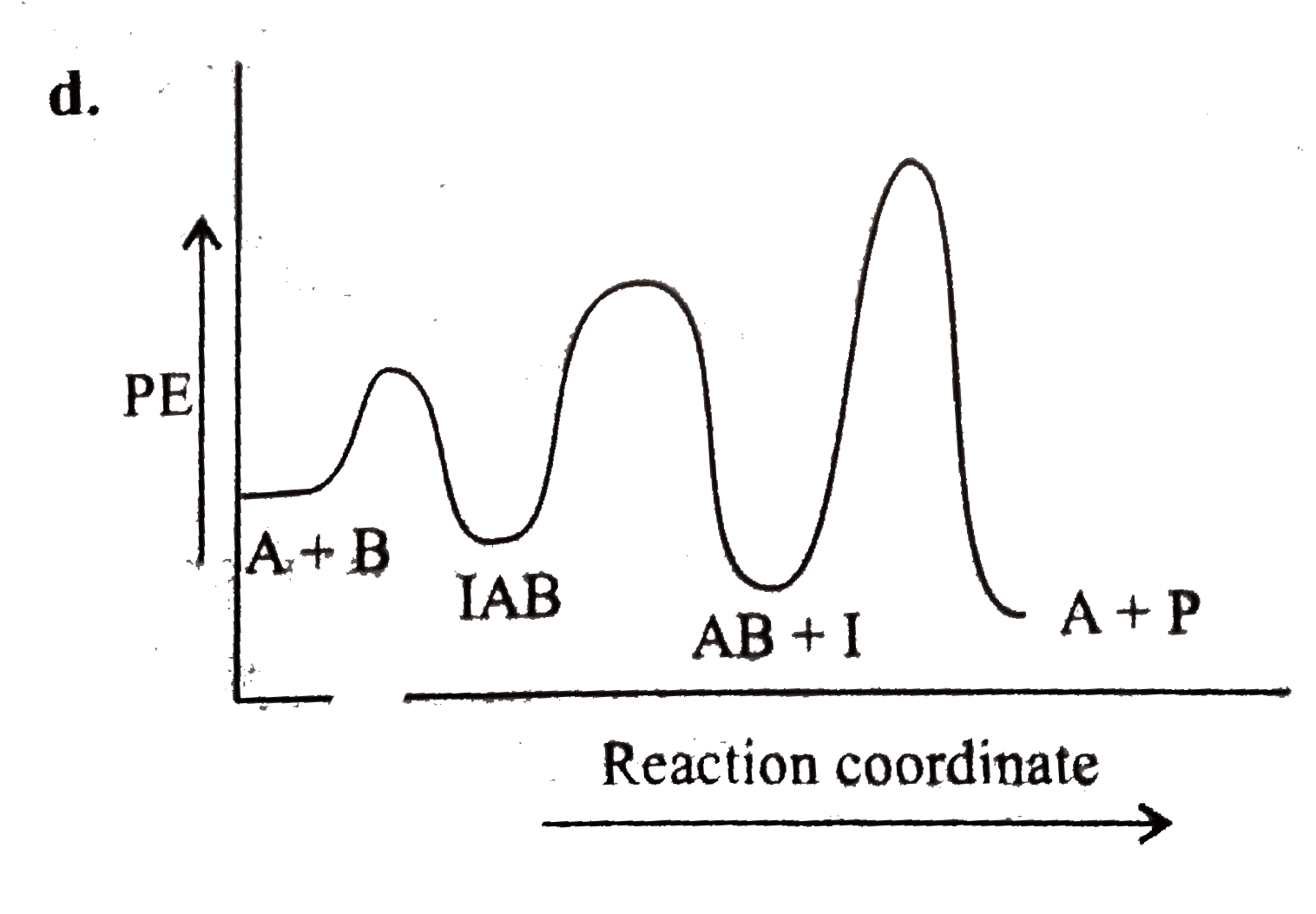The following mechanism has been proposed for the exothermic catalyzed cmplex reaction:
A+BFast−−→IABk1−−→AB+Ik2−−→P+A
If k1 is much smaller than k2, the most suitable qualitative plot of potential energy (PE) versus reaction coordinates for the above reaction is




The correct Answer is:D
To solve the problem regarding the potential energy (PE) versus reaction coordinates for the given reaction mechanism, we will follow these steps:
Step 1: Understand the Reaction Mechanism
The reaction mechanism provided is:
1. A+BFast→IAB
2. IABk1→AB+I
3. ABk2→P+A
Here, k1 is much smaller than k2, indicating that the first step is slow compared to the second step.
Step 2: Identify the Nature of the Reaction
The problem states that the reaction is exothermic. This means that the enthalpy of the products is lower than that of the reactants. Therefore, the potential energy of the products will be lower than that of the reactants in the PE vs. reaction coordinate graph.
Step 3: Analyze Activation Energies
- Since k1 is much smaller than k2, the activation energy for the step involving k1 (the formation of IAB) will be higher than that for the step involving k2 (the conversion of AB to P+A).
- The first step is fast, indicating that it has a low activation energy, while the second step has a higher activation energy.
Step 4: Evaluate the Graph Options
- Graph A: Shows a lower potential energy for products compared to reactants and has a reasonable activation energy for the first step.
- Graph B: Shows a higher potential energy for products, which is incorrect for an exothermic reaction.
- Graph C: Shows a high activation energy for the first step, which is not consistent with the fast reaction.
- Graph D: Also shows a high activation energy for the first step, which is not consistent with the fast reaction.
Conclusion
Given the analysis, the most suitable qualitative plot of potential energy versus reaction coordinates for the reaction is Graph A.
Final Answer
The correct option is A.
---
The reaction mechanism provided is:
1. A+BFast→IAB
2. IABk1→AB+I
3. ABk2→P+A
The problem states that the reaction is exothermic. This means that the enthalpy of the products is lower than that of the reactants. Therefore, the potential energy of the products will be lower than that of the reactants in the PE vs. reaction coordinate graph.
- Since k1 is much smaller than k2, the activation energy for the step involving k1 (the formation of IAB) will be higher than that for the step involving k2 (the conversion of AB to P+A).
- The first step is fast, indicating that it has a low activation energy, while the second step has a higher activation energy.
- Graph A: Shows a lower potential energy for products compared to reactants and has a reasonable activation energy for the first step.
- Graph B: Shows a higher potential energy for products, which is incorrect for an exothermic reaction.
- Graph C: Shows a high activation energy for the first step, which is not consistent with the fast reaction.
- Graph D: Also shows a high activation energy for the first step, which is not consistent with the fast reaction.
Given the analysis, the most suitable qualitative plot of potential energy versus reaction coordinates for the reaction is Graph A.
The correct option is A.
Topper's Solved these Questions
- CHEMICAL KINETICSBOOK - CENGAGE CHEMISTRY ENGLISHCHAPTER - CHEMICAL KINETICSEXERCISE - Ex 4.3 (Objective)
15 Videos
- CHEMICAL KINETICSBOOK - CENGAGE CHEMISTRY ENGLISHCHAPTER - CHEMICAL KINETICSEXERCISE - Ex 4.3 More Than One Correct
5 Videos
- CHEMICAL KINETICSBOOK - CENGAGE CHEMISTRY ENGLISHCHAPTER - CHEMICAL KINETICSEXERCISE - Ex 4.1 (Objective)
9 Videos
- CARBOXYLIC ACIDS AND THEIR DERIVATIVESBOOK - CENGAGE CHEMISTRY ENGLISHCHAPTER - CARBOXYLIC ACIDS AND THEIR DERIVATIVESEXERCISE - Exercises Archives (Analytical And Descriptive)
34 Videos
- COORDINATION COMPOUNDSBOOK - CENGAGE CHEMISTRY ENGLISHCHAPTER - COORDINATION COMPOUNDSEXERCISE - Archives Subjective
18 Videos
Similar Questions
Mechanism of the reaction is:
Ak1−−→B,2Ak2−−→C+D
What is −d[A]dt ?
View SolutionThe overall rate d[P]dt, for the reaction 2AK⇐⇒B,B+Ckf−−→P is given by
View SolutionIn the series reaction
AK2−−→BK2−−→CK2−−→D , if K1>K2>K3 then the rate determing step of the reaction is
View SolutionMechanism of the reaction is:
A2k2⇐⇒2A
A+Bk2−−→C
A2+Ck−−→D+A
What is d[D]dt ?
View SolutionMechanism of the reaction is:
A2k⇐⇒k'2A
A+B2k2−−→C+B
B+A2k2−−→C+A
What is−d[A2]dt
View SolutionConisder a mechanism in which a single reactant profuces several Products by the following parallel first order reactions :
Ak1−−→B,Ak2−−→CAk3−−→D
Write the rate expresison for [A].
View SolutionA following mechanism has been proposed for a reaction
2A+B→D→E
A+B→C+D(slow)
A+C→E (fast)
The rate law expression for the reaction by RDS methd is:
View SolutionFor an elementary chemical reaction, A2k1⇐===⇒k−12A, the expression for d[A]dt is
View SolutionFor an elementary chemical reaction, A2k1⇐===⇒k−12A, the expression for d[A]dt is
View SolutionFor a reaction scheme Ak1−−→Bk2−−→D , If the rate of formation if B is set to be Zero then the concentration of B is given by :
View Solution
